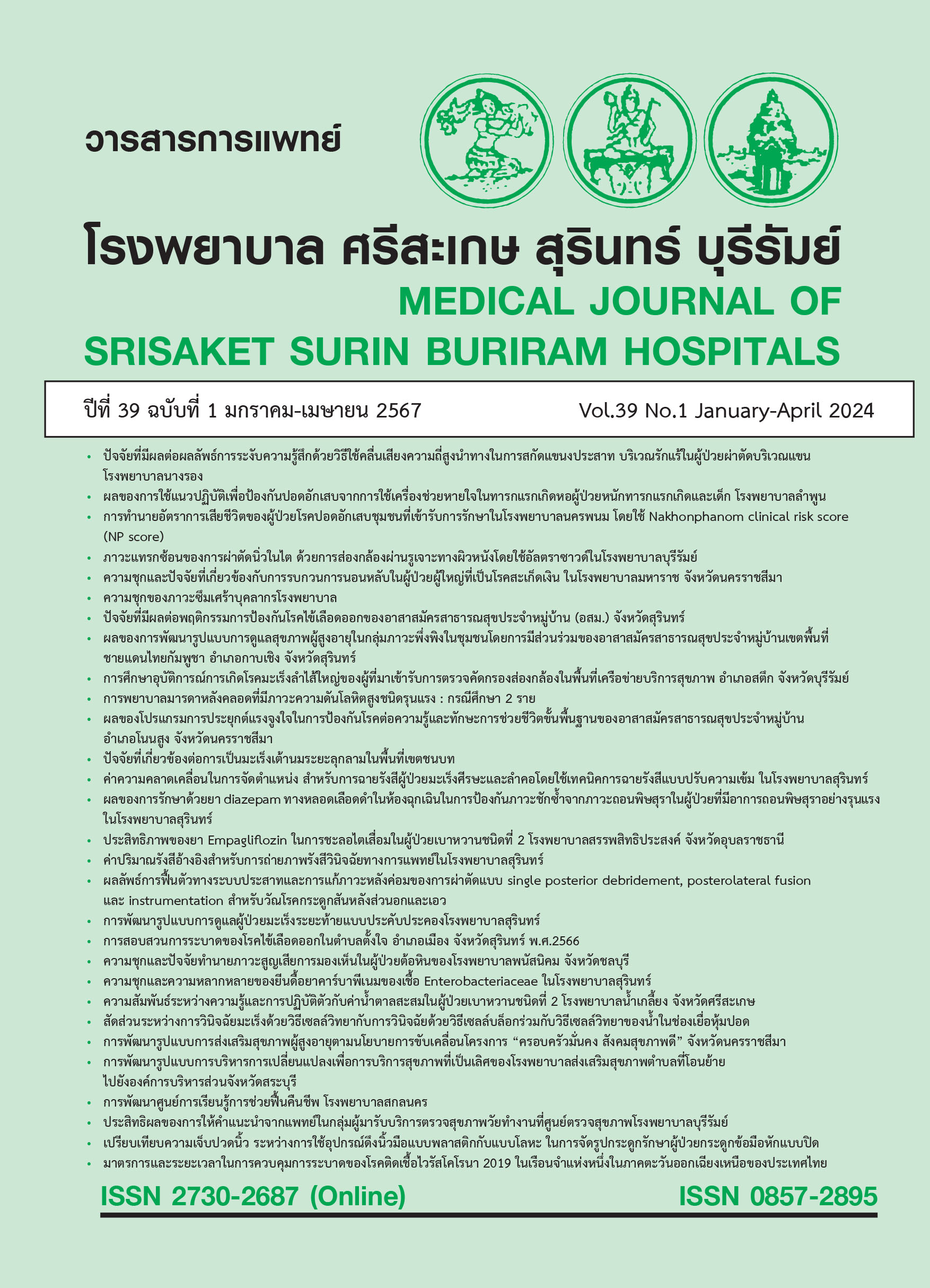ภาวะแทรกซ้อนของการผ่าตัดนิ่วในไต ด้วยการส่องกล้องผ่านรูเจาะทางผิวหนัง โดยใช้อัลตราซาวด์ ในโรงพยาบาลบุรีรัมย์
Main Article Content
บทคัดย่อ
วัตถุประสงค์: เพื่อศึกษาถึงประสิทธิภาพและภาวะแทรกซ้อนของการทำ PCNL โดยใช้ Ultrasound เป็นตัวนำทาง ในท่า Flank
วิธีการศึกษา: เป็นการศึกษาแบบ Retrospective cohort study ในผู้ป่วยโรคนิ่วในไตจำนวน 342 คน ที่ได้รับการผ่าตัด PCNL โดยใช้ Ultrasound เป็นตัวนำทาง ในท่า Flank ในโรงพยาบาลบุรีรัมย์ ตั้งแต่ปี พ.ศ.2557 ถึง ปี พ.ศ.2566 บันทึกขนาด ระยะเวลาผ่าตัด จำนวนวันนอนโรงพยาบาล ประเมินอัตราการหมดไปของนิ่วและภาวะแทรกซ้อนหลังการผ่าตัด
ผลการศึกษา: ผู้ป่วยได้รับการผ่าตัด PCNL โดยใช้ Ultrasound-guide พบ Stone free rate ร้อยละ 30.7 จำนวนวันนอนโรงพยาบาลเฉลี่ย 9 วัน ใช้ระยะเวลาในการผ่าตัดเฉลี่ย 100 นาที มีการให้ เลือดทดแทน 32 ราย (ร้อยละ9.4) พบการติดเชื้อทางเดินปัสสาวะและมีไข้หลังผ่าตัด 78 ราย (ร้อยละ 21.9) โดยมีภาวะ Septic shock 18 ราย (ร้อยละ 5.3) พบการทะลุเล็กน้อยของกรวย ไต 7 ราย (ร้อยละ2) และมีภาวะท่อไตอุดตันหลังผ่าตัด 46 ราย (ร้อยละ 13.5) ไม่พบการบาดเจ็บของช่องอกหรืออวัยวะในช่องท้อง ไม่มีผู้ป่วยเสียชีวิต
สรุป: การผ่าตัด PCNL โดยใช้ Ultrasound เป็นตัวนำทาง ในท่า Flank สามารถทำได้อย่างปลอดภัย ช่วยลดขนาดและจำนวนนิ่วในไต(Stone burden) ช่วยลดโอกาสในการบาดเจ็บของช่องอกหรืออวัยวะในช่องท้อง และช่วยลดการสัมผัสรังสีของบุคลากรทีมผ่าตัดจากการทำงาน
Article Details

อนุญาตภายใต้เงื่อนไข Creative Commons Attribution-NonCommercial-NoDerivatives 4.0 International License.
เอกสารอ้างอิง
Pearle MS, Calhoun EA, Curhan GC; Urologic Diseases of America Project. Urologic diseases in America project: urolithiasis. J Urol 2005;173(3):848-57. doi: 10.1097/01.ju.0000152082.14384.d7.
Soucie JM, Thun MJ, Coates RJ, McClellan W, Austin H. Demographic and geographic variability of kidney stones in the United States. Kidney Int 1994;46(3):893-9. doi: 10.1038/ki.1994.347.
Johnson CM, Wilson DM, O'Fallon WM, Malek RS, Kurland LT. Renal stone epidemiology: a 25-year study in Rochester, Minnesota. Kidney Int 1979;16(5):624-31. doi: 10.1038/ki.1979.173.
Marshall V, White RH, De Saintonge MC, Tresidder GC, Blandy JP. The natural history of renal and ureteric calculi. Br J Urol 1975;47(2):117-24. doi: 10.1111/j.1464-410x.1975.tb03930.x.
Segura JW, Patterson DE, LeRoy AJ, Williams HJ Jr, Barrett DM, Benson RC Jr, et al. Percutaneous removal of kidney stones: review of 1,000 cases. J Urol 1985;134(6):1077-81. doi: 10.1016/s0022-5347(17)47633-6.
Preminger GM, Assimos DG, Lingeman JE, Nakada SY, Pearle MS, Wolf JS Jr, et al. Chapter 1: AUA guideline on management of staghorn calculi: diagnosis and treatment recommendations. J Urol 2005;173(6):1991-2000. doi: 10.1097/01.ju.0000161171.67806.2a.
de la Rosette J, Assimos D, Desai M, Gutierrez J, Lingeman J, Scarpa R, et al. The Clinical Research Office of the Endourological Society Percutaneous Nephrolithotomy Global Study: indications, complications, and outcomes in 5803 patients. J Endourol 2011;25(1):11-7. doi: 10.1089/end.2010.0424.
Keoghane SR, Cetti RJ, Rogers AE, Walmsley BH. Blood transfusion, embolisation and nephrectomy after percutaneous nephrolithotomy (PCNL). BJU Int 2013;111(4):628-32. doi: 10.1111/j.1464-410X.2012.11394.x.
Picus D, Weyman PJ, Clayman RV, McClennan BL. Intercostal-space nephrostomy for percutaneous stone removal. AJR Am J Roentgenol 1986;147(2):393-7. doi: 10.2214/ajr.147.2.393.
Deane LA, Clayman RV. Advances in percutaneous nephrostolithotomy. Urol Clin North Am 2007;34(3):383-95. doi: 10.1016/j.ucl.2007.04.002.
Tzou DT, Tailly TO, Stern KL. Ultrasound-Guided PCNL - Why Are We Still Performing Exclusively Fluoroscopic Access? Curr Urol Rep 2023;24(7):335-43. doi: 10.1007/s11934-023-01163-8.
เชาวน์วัศ พิมพ์รัตน์. ประสิทธิภาพและความปลอดภัยของการผ่าตัดนิ่วในไตด้วยวิธีเจาะรูผ่านผิวหนังในท่าผ่าตัดไต (Kidney Position) โดยปราศจากการใช้รังสี. วารสารยูโร 2554;32(2):90-4.
Arabzadeh Bahri R, Maleki S, Shafiee A, Shobeiri P. Ultrasound versus fluoroscopy as imaging guidance for percutaneous nephrolithotomy: A systematic review and meta-analysis. PLoS One 2023;18(3):e0276708. doi: 10.1371/journal.pone.0276708.
Ng FC, Yam WL, Lim TYB, Teo JK, Ng KK, Lim SK. Ultrasound-guided percutaneous nephrolithotomy: Advantages and limitations. Investig Clin Urol 2017;58(5):346-52. doi: 10.4111/icu.2017.58.5.346.


